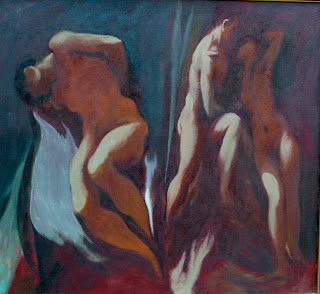Harry Carmean is one of the few authentic interpreters of Mannerism today which can especially be seen in his monumental figurative paintings with complex compositions. Mannerism, which evolved out of the Renaissance, started as a reaction against the harmonious ideas of classicism (that were the hallmark of the Renaissance) and sought to introduce new visual approaches to painting. The Mannerists of that time explored more discordant and distorted compositions and introduced the idea of making "art for its own sake", a concept relevant to modern times. As a way of pushing away from the traditional harmonious way of working, the Mannerists would exaggerate the perspective in their paintings. They put the horizon at the bottom of the painting, used two different perspectives or employed extreme foreshortening. The figures were more distorted, that is, they were often unnaturally elongated, the heads were too small in comparison to the rest of the figure, and there was an unnatural fluidity to the figures. The forms were distorted and "played with" by the artists, to create interesting new effects. The Mannerist colors were more garish and unnatural which helped provide visual excitement. Size change within a painting was used with dramatic effect - the very large would be placed next to the very small to create a feeling of monumentality. The ideas mentioned above are what help to make the Mannerists inspirational to the centuries of artists that followed them. In a sense, they were "modern" in the way that they played with form, focused on the aesthetic over the reality, and pushed their audiences' perceptions to the limit.
Harry Carmean remains one of the best interpreters of the Mannerist school of thought because he fully understands Mannerist concepts used and also has the technique necessary to execute these ideas. The unworldly color schemes, elongated and distorted figures, unusual perspectives and/or extreme foreshortening make many of Carmean's paintings excellent interpretations of concepts seen within Italian Mannerism of the 16 century.


No comments:
Post a Comment